Comprehensive Report: Personal Work Priorities and Development
VerifiedAdded on 2021/02/21
|16
|5620
|27
Report
AI Summary
This report delves into the crucial aspects of managing personal work priorities and fostering professional development. It begins by defining self-appraisal and peer appraisal, highlighting their contributions to performance reviews and identifying the benefits of each. The report then explores the importance of planning work, including its role in providing organizational direction, establishing teamwork, and guiding decision-making. It explains the SMART goal framework and the Pareto Principle in relation to time management. Furthermore, the report discusses the signs of stress, strategies for managing it, and the significance of work-life balance. It also examines the negative impacts of technology usage and offers insights into maintaining a healthy balance. The report concludes by addressing personal development planning, including behavioral assessments and learning styles, to provide a comprehensive understanding of personal and professional growth. The report also includes examples of meeting with an assessor and personal work goals.
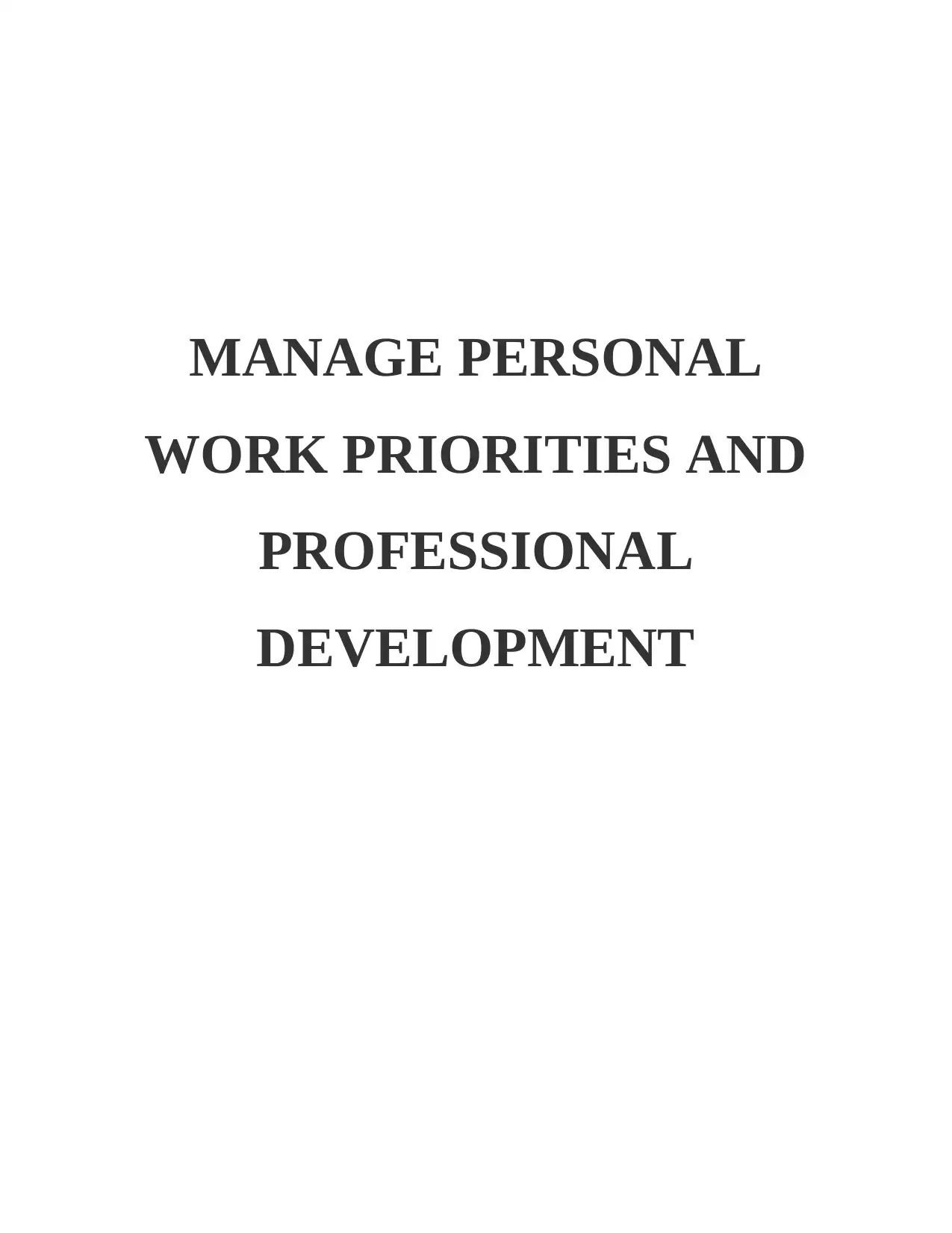
MANAGE PERSONAL
WORK PRIORITIES AND
PROFESSIONAL
DEVELOPMENT
WORK PRIORITIES AND
PROFESSIONAL
DEVELOPMENT
Paraphrase This Document
Need a fresh take? Get an instant paraphrase of this document with our AI Paraphraser
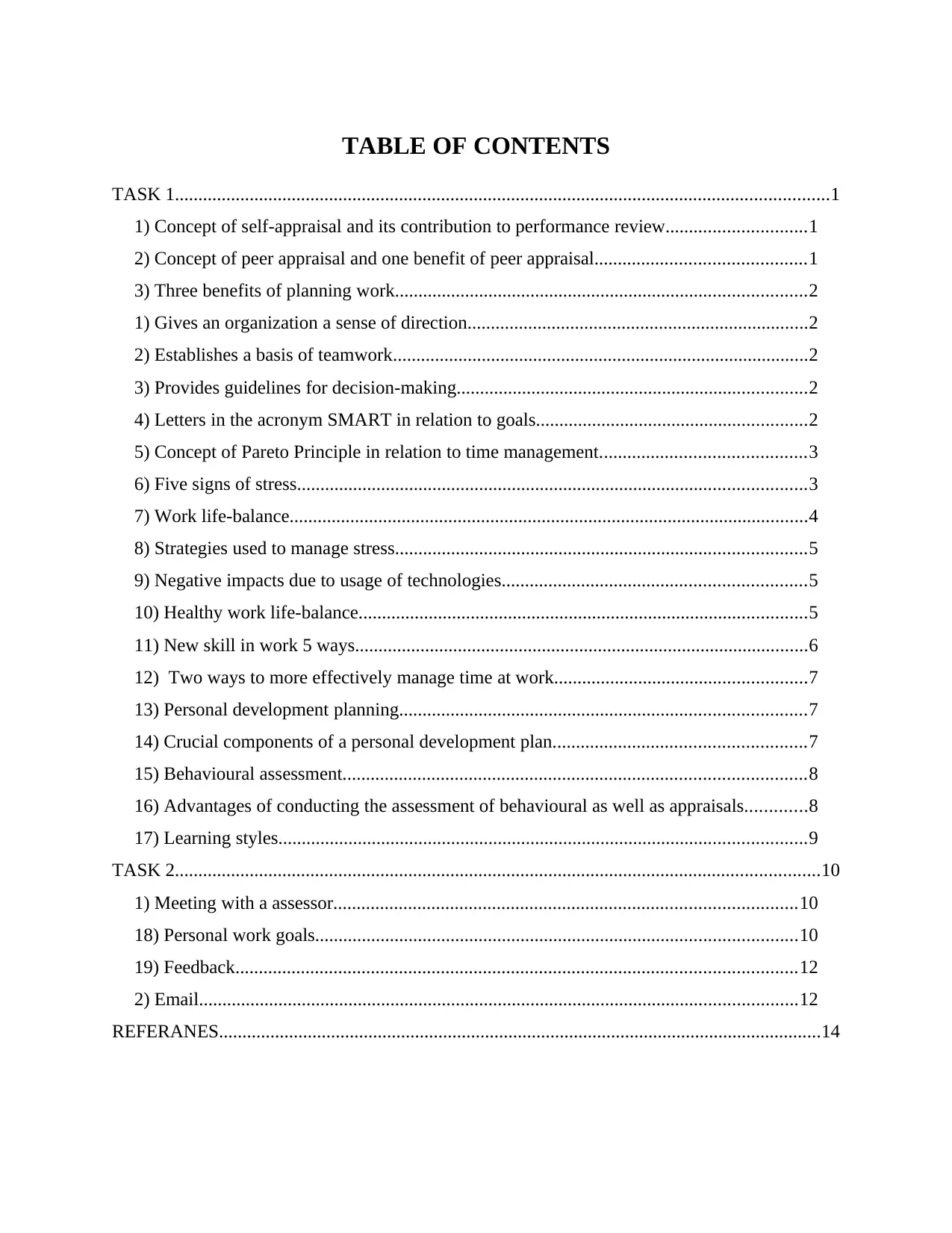
TABLE OF CONTENTS
TASK 1............................................................................................................................................1
1) Concept of self-appraisal and its contribution to performance review..............................1
2) Concept of peer appraisal and one benefit of peer appraisal.............................................1
3) Three benefits of planning work........................................................................................2
1) Gives an organization a sense of direction.........................................................................2
2) Establishes a basis of teamwork.........................................................................................2
3) Provides guidelines for decision-making...........................................................................2
4) Letters in the acronym SMART in relation to goals..........................................................2
5) Concept of Pareto Principle in relation to time management............................................3
6) Five signs of stress.............................................................................................................3
7) Work life-balance...............................................................................................................4
8) Strategies used to manage stress........................................................................................5
9) Negative impacts due to usage of technologies.................................................................5
10) Healthy work life-balance................................................................................................5
11) New skill in work 5 ways.................................................................................................6
12) Two ways to more effectively manage time at work......................................................7
13) Personal development planning.......................................................................................7
14) Crucial components of a personal development plan......................................................7
15) Behavioural assessment...................................................................................................8
16) Advantages of conducting the assessment of behavioural as well as appraisals.............8
17) Learning styles.................................................................................................................9
TASK 2..........................................................................................................................................10
1) Meeting with a assessor...................................................................................................10
18) Personal work goals.......................................................................................................10
19) Feedback........................................................................................................................12
2) Email................................................................................................................................12
REFERANES.................................................................................................................................14
TASK 1............................................................................................................................................1
1) Concept of self-appraisal and its contribution to performance review..............................1
2) Concept of peer appraisal and one benefit of peer appraisal.............................................1
3) Three benefits of planning work........................................................................................2
1) Gives an organization a sense of direction.........................................................................2
2) Establishes a basis of teamwork.........................................................................................2
3) Provides guidelines for decision-making...........................................................................2
4) Letters in the acronym SMART in relation to goals..........................................................2
5) Concept of Pareto Principle in relation to time management............................................3
6) Five signs of stress.............................................................................................................3
7) Work life-balance...............................................................................................................4
8) Strategies used to manage stress........................................................................................5
9) Negative impacts due to usage of technologies.................................................................5
10) Healthy work life-balance................................................................................................5
11) New skill in work 5 ways.................................................................................................6
12) Two ways to more effectively manage time at work......................................................7
13) Personal development planning.......................................................................................7
14) Crucial components of a personal development plan......................................................7
15) Behavioural assessment...................................................................................................8
16) Advantages of conducting the assessment of behavioural as well as appraisals.............8
17) Learning styles.................................................................................................................9
TASK 2..........................................................................................................................................10
1) Meeting with a assessor...................................................................................................10
18) Personal work goals.......................................................................................................10
19) Feedback........................................................................................................................12
2) Email................................................................................................................................12
REFERANES.................................................................................................................................14
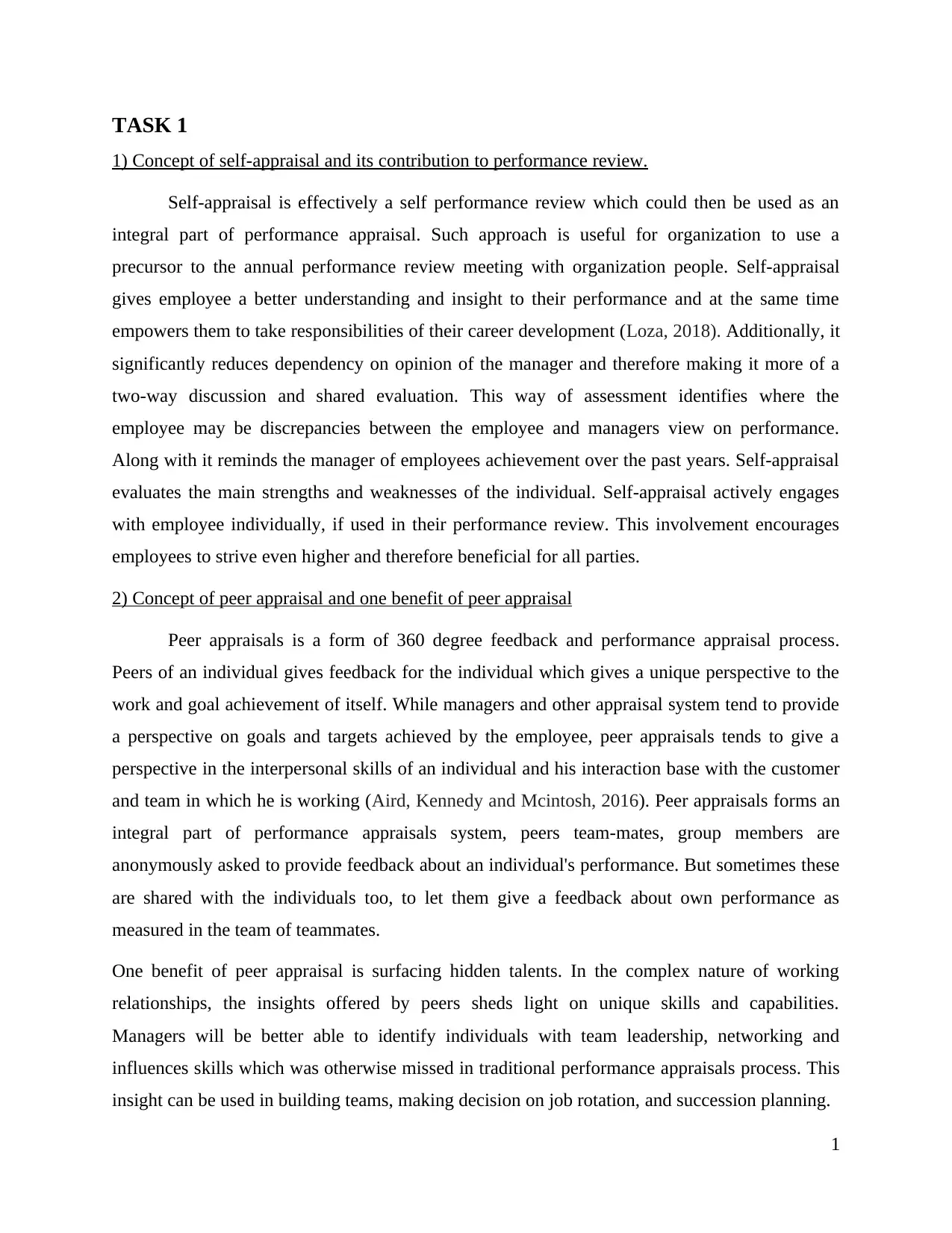
TASK 1
1) Concept of self-appraisal and its contribution to performance review.
Self-appraisal is effectively a self performance review which could then be used as an
integral part of performance appraisal. Such approach is useful for organization to use a
precursor to the annual performance review meeting with organization people. Self-appraisal
gives employee a better understanding and insight to their performance and at the same time
empowers them to take responsibilities of their career development (Loza, 2018). Additionally, it
significantly reduces dependency on opinion of the manager and therefore making it more of a
two-way discussion and shared evaluation. This way of assessment identifies where the
employee may be discrepancies between the employee and managers view on performance.
Along with it reminds the manager of employees achievement over the past years. Self-appraisal
evaluates the main strengths and weaknesses of the individual. Self-appraisal actively engages
with employee individually, if used in their performance review. This involvement encourages
employees to strive even higher and therefore beneficial for all parties.
2) Concept of peer appraisal and one benefit of peer appraisal
Peer appraisals is a form of 360 degree feedback and performance appraisal process.
Peers of an individual gives feedback for the individual which gives a unique perspective to the
work and goal achievement of itself. While managers and other appraisal system tend to provide
a perspective on goals and targets achieved by the employee, peer appraisals tends to give a
perspective in the interpersonal skills of an individual and his interaction base with the customer
and team in which he is working (Aird, Kennedy and Mcintosh, 2016). Peer appraisals forms an
integral part of performance appraisals system, peers team-mates, group members are
anonymously asked to provide feedback about an individual's performance. But sometimes these
are shared with the individuals too, to let them give a feedback about own performance as
measured in the team of teammates.
One benefit of peer appraisal is surfacing hidden talents. In the complex nature of working
relationships, the insights offered by peers sheds light on unique skills and capabilities.
Managers will be better able to identify individuals with team leadership, networking and
influences skills which was otherwise missed in traditional performance appraisals process. This
insight can be used in building teams, making decision on job rotation, and succession planning.
1
1) Concept of self-appraisal and its contribution to performance review.
Self-appraisal is effectively a self performance review which could then be used as an
integral part of performance appraisal. Such approach is useful for organization to use a
precursor to the annual performance review meeting with organization people. Self-appraisal
gives employee a better understanding and insight to their performance and at the same time
empowers them to take responsibilities of their career development (Loza, 2018). Additionally, it
significantly reduces dependency on opinion of the manager and therefore making it more of a
two-way discussion and shared evaluation. This way of assessment identifies where the
employee may be discrepancies between the employee and managers view on performance.
Along with it reminds the manager of employees achievement over the past years. Self-appraisal
evaluates the main strengths and weaknesses of the individual. Self-appraisal actively engages
with employee individually, if used in their performance review. This involvement encourages
employees to strive even higher and therefore beneficial for all parties.
2) Concept of peer appraisal and one benefit of peer appraisal
Peer appraisals is a form of 360 degree feedback and performance appraisal process.
Peers of an individual gives feedback for the individual which gives a unique perspective to the
work and goal achievement of itself. While managers and other appraisal system tend to provide
a perspective on goals and targets achieved by the employee, peer appraisals tends to give a
perspective in the interpersonal skills of an individual and his interaction base with the customer
and team in which he is working (Aird, Kennedy and Mcintosh, 2016). Peer appraisals forms an
integral part of performance appraisals system, peers team-mates, group members are
anonymously asked to provide feedback about an individual's performance. But sometimes these
are shared with the individuals too, to let them give a feedback about own performance as
measured in the team of teammates.
One benefit of peer appraisal is surfacing hidden talents. In the complex nature of working
relationships, the insights offered by peers sheds light on unique skills and capabilities.
Managers will be better able to identify individuals with team leadership, networking and
influences skills which was otherwise missed in traditional performance appraisals process. This
insight can be used in building teams, making decision on job rotation, and succession planning.
1
⊘ This is a preview!⊘
Do you want full access?
Subscribe today to unlock all pages.

Trusted by 1+ million students worldwide
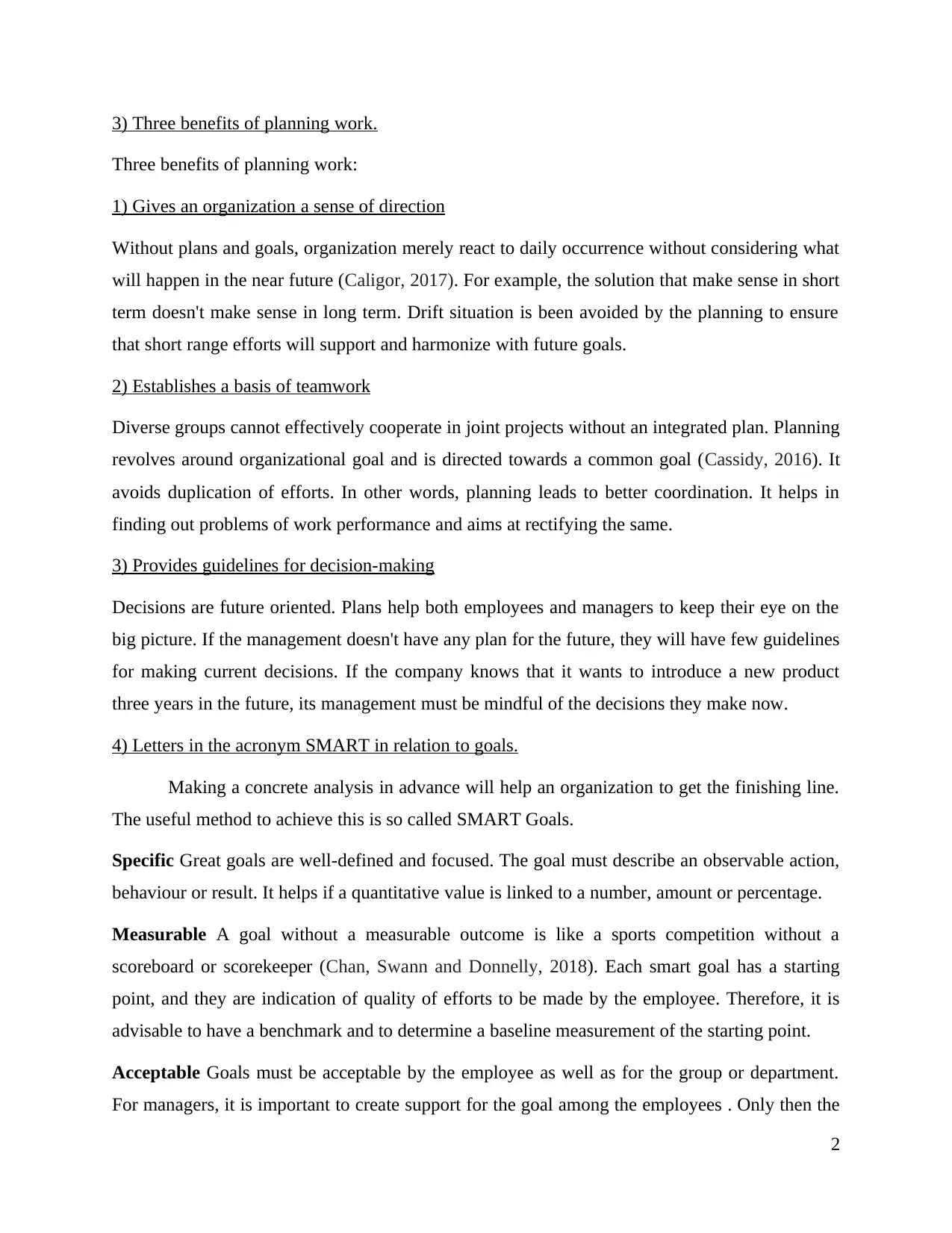
3) Three benefits of planning work.
Three benefits of planning work:
1) Gives an organization a sense of direction
Without plans and goals, organization merely react to daily occurrence without considering what
will happen in the near future (Caligor, 2017). For example, the solution that make sense in short
term doesn't make sense in long term. Drift situation is been avoided by the planning to ensure
that short range efforts will support and harmonize with future goals.
2) Establishes a basis of teamwork
Diverse groups cannot effectively cooperate in joint projects without an integrated plan. Planning
revolves around organizational goal and is directed towards a common goal (Cassidy, 2016). It
avoids duplication of efforts. In other words, planning leads to better coordination. It helps in
finding out problems of work performance and aims at rectifying the same.
3) Provides guidelines for decision-making
Decisions are future oriented. Plans help both employees and managers to keep their eye on the
big picture. If the management doesn't have any plan for the future, they will have few guidelines
for making current decisions. If the company knows that it wants to introduce a new product
three years in the future, its management must be mindful of the decisions they make now.
4) Letters in the acronym SMART in relation to goals.
Making a concrete analysis in advance will help an organization to get the finishing line.
The useful method to achieve this is so called SMART Goals.
Specific Great goals are well-defined and focused. The goal must describe an observable action,
behaviour or result. It helps if a quantitative value is linked to a number, amount or percentage.
Measurable A goal without a measurable outcome is like a sports competition without a
scoreboard or scorekeeper (Chan, Swann and Donnelly, 2018). Each smart goal has a starting
point, and they are indication of quality of efforts to be made by the employee. Therefore, it is
advisable to have a benchmark and to determine a baseline measurement of the starting point.
Acceptable Goals must be acceptable by the employee as well as for the group or department.
For managers, it is important to create support for the goal among the employees . Only then the
2
Three benefits of planning work:
1) Gives an organization a sense of direction
Without plans and goals, organization merely react to daily occurrence without considering what
will happen in the near future (Caligor, 2017). For example, the solution that make sense in short
term doesn't make sense in long term. Drift situation is been avoided by the planning to ensure
that short range efforts will support and harmonize with future goals.
2) Establishes a basis of teamwork
Diverse groups cannot effectively cooperate in joint projects without an integrated plan. Planning
revolves around organizational goal and is directed towards a common goal (Cassidy, 2016). It
avoids duplication of efforts. In other words, planning leads to better coordination. It helps in
finding out problems of work performance and aims at rectifying the same.
3) Provides guidelines for decision-making
Decisions are future oriented. Plans help both employees and managers to keep their eye on the
big picture. If the management doesn't have any plan for the future, they will have few guidelines
for making current decisions. If the company knows that it wants to introduce a new product
three years in the future, its management must be mindful of the decisions they make now.
4) Letters in the acronym SMART in relation to goals.
Making a concrete analysis in advance will help an organization to get the finishing line.
The useful method to achieve this is so called SMART Goals.
Specific Great goals are well-defined and focused. The goal must describe an observable action,
behaviour or result. It helps if a quantitative value is linked to a number, amount or percentage.
Measurable A goal without a measurable outcome is like a sports competition without a
scoreboard or scorekeeper (Chan, Swann and Donnelly, 2018). Each smart goal has a starting
point, and they are indication of quality of efforts to be made by the employee. Therefore, it is
advisable to have a benchmark and to determine a baseline measurement of the starting point.
Acceptable Goals must be acceptable by the employee as well as for the group or department.
For managers, it is important to create support for the goal among the employees . Only then the
2
Paraphrase This Document
Need a fresh take? Get an instant paraphrase of this document with our AI Paraphraser
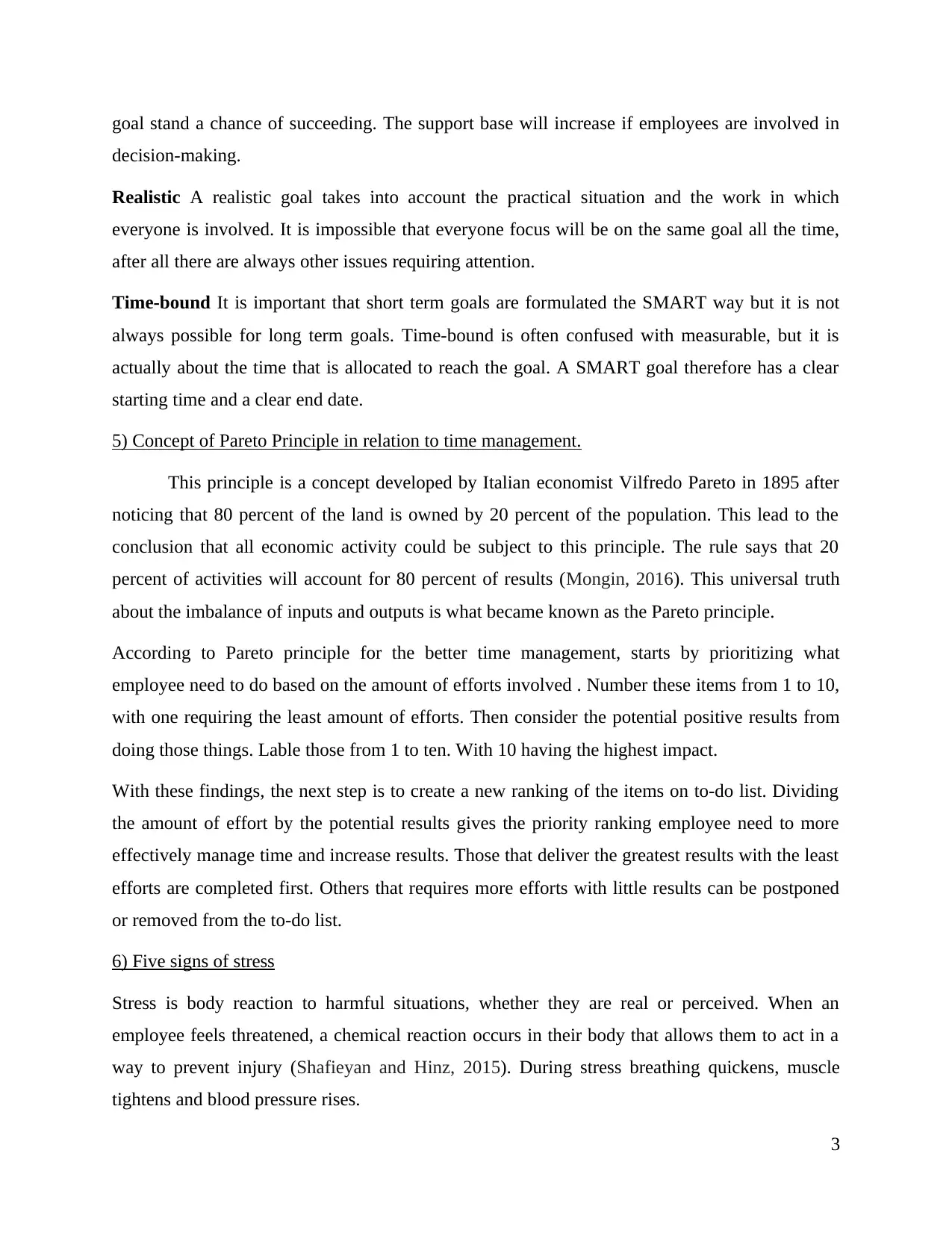
goal stand a chance of succeeding. The support base will increase if employees are involved in
decision-making.
Realistic A realistic goal takes into account the practical situation and the work in which
everyone is involved. It is impossible that everyone focus will be on the same goal all the time,
after all there are always other issues requiring attention.
Time-bound It is important that short term goals are formulated the SMART way but it is not
always possible for long term goals. Time-bound is often confused with measurable, but it is
actually about the time that is allocated to reach the goal. A SMART goal therefore has a clear
starting time and a clear end date.
5) Concept of Pareto Principle in relation to time management.
This principle is a concept developed by Italian economist Vilfredo Pareto in 1895 after
noticing that 80 percent of the land is owned by 20 percent of the population. This lead to the
conclusion that all economic activity could be subject to this principle. The rule says that 20
percent of activities will account for 80 percent of results (Mongin, 2016). This universal truth
about the imbalance of inputs and outputs is what became known as the Pareto principle.
According to Pareto principle for the better time management, starts by prioritizing what
employee need to do based on the amount of efforts involved . Number these items from 1 to 10,
with one requiring the least amount of efforts. Then consider the potential positive results from
doing those things. Lable those from 1 to ten. With 10 having the highest impact.
With these findings, the next step is to create a new ranking of the items on to-do list. Dividing
the amount of effort by the potential results gives the priority ranking employee need to more
effectively manage time and increase results. Those that deliver the greatest results with the least
efforts are completed first. Others that requires more efforts with little results can be postponed
or removed from the to-do list.
6) Five signs of stress
Stress is body reaction to harmful situations, whether they are real or perceived. When an
employee feels threatened, a chemical reaction occurs in their body that allows them to act in a
way to prevent injury (Shafieyan and Hinz, 2015). During stress breathing quickens, muscle
tightens and blood pressure rises.
3
decision-making.
Realistic A realistic goal takes into account the practical situation and the work in which
everyone is involved. It is impossible that everyone focus will be on the same goal all the time,
after all there are always other issues requiring attention.
Time-bound It is important that short term goals are formulated the SMART way but it is not
always possible for long term goals. Time-bound is often confused with measurable, but it is
actually about the time that is allocated to reach the goal. A SMART goal therefore has a clear
starting time and a clear end date.
5) Concept of Pareto Principle in relation to time management.
This principle is a concept developed by Italian economist Vilfredo Pareto in 1895 after
noticing that 80 percent of the land is owned by 20 percent of the population. This lead to the
conclusion that all economic activity could be subject to this principle. The rule says that 20
percent of activities will account for 80 percent of results (Mongin, 2016). This universal truth
about the imbalance of inputs and outputs is what became known as the Pareto principle.
According to Pareto principle for the better time management, starts by prioritizing what
employee need to do based on the amount of efforts involved . Number these items from 1 to 10,
with one requiring the least amount of efforts. Then consider the potential positive results from
doing those things. Lable those from 1 to ten. With 10 having the highest impact.
With these findings, the next step is to create a new ranking of the items on to-do list. Dividing
the amount of effort by the potential results gives the priority ranking employee need to more
effectively manage time and increase results. Those that deliver the greatest results with the least
efforts are completed first. Others that requires more efforts with little results can be postponed
or removed from the to-do list.
6) Five signs of stress
Stress is body reaction to harmful situations, whether they are real or perceived. When an
employee feels threatened, a chemical reaction occurs in their body that allows them to act in a
way to prevent injury (Shafieyan and Hinz, 2015). During stress breathing quickens, muscle
tightens and blood pressure rises.
3
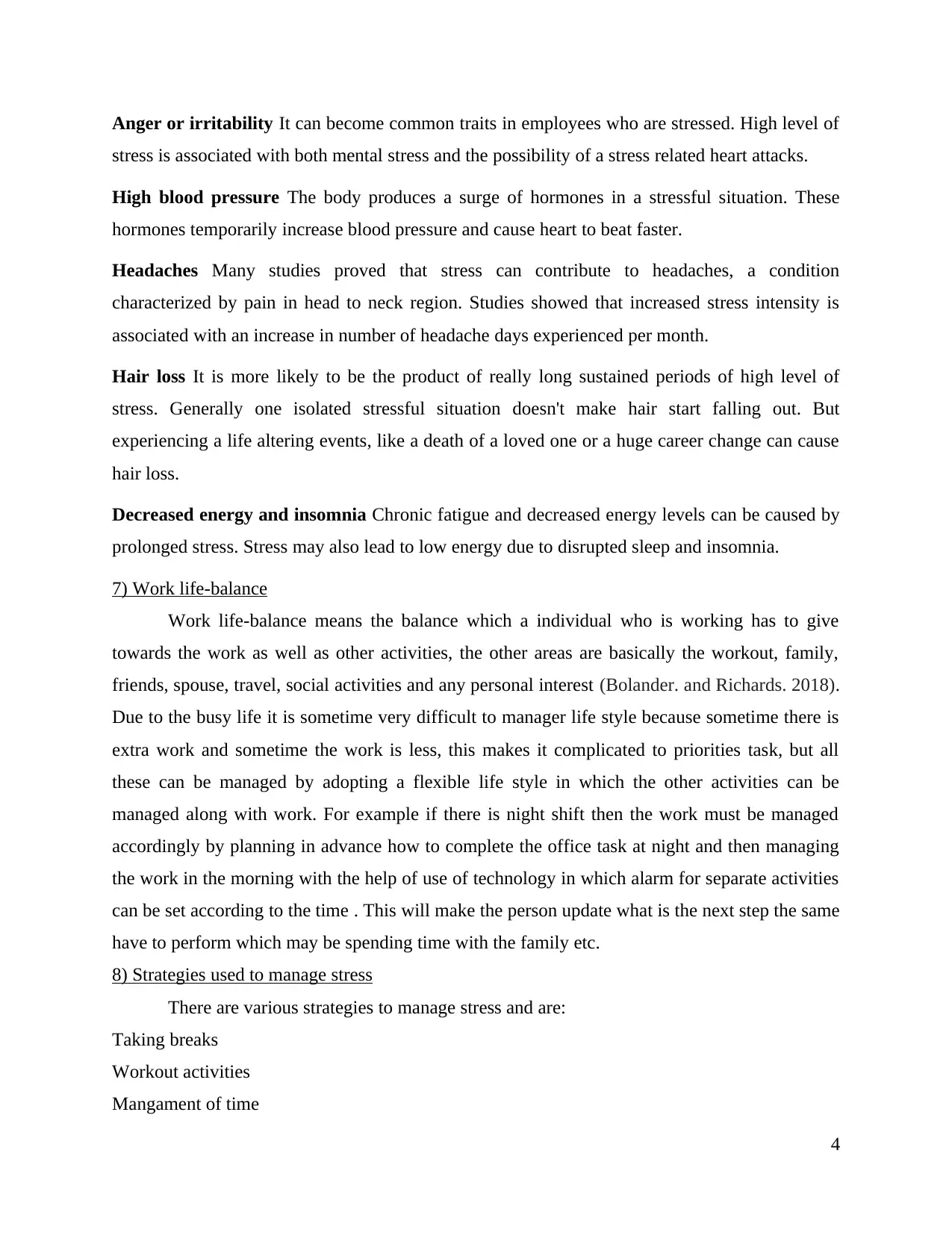
Anger or irritability It can become common traits in employees who are stressed. High level of
stress is associated with both mental stress and the possibility of a stress related heart attacks.
High blood pressure The body produces a surge of hormones in a stressful situation. These
hormones temporarily increase blood pressure and cause heart to beat faster.
Headaches Many studies proved that stress can contribute to headaches, a condition
characterized by pain in head to neck region. Studies showed that increased stress intensity is
associated with an increase in number of headache days experienced per month.
Hair loss It is more likely to be the product of really long sustained periods of high level of
stress. Generally one isolated stressful situation doesn't make hair start falling out. But
experiencing a life altering events, like a death of a loved one or a huge career change can cause
hair loss.
Decreased energy and insomnia Chronic fatigue and decreased energy levels can be caused by
prolonged stress. Stress may also lead to low energy due to disrupted sleep and insomnia.
7) Work life-balance
Work life-balance means the balance which a individual who is working has to give
towards the work as well as other activities, the other areas are basically the workout, family,
friends, spouse, travel, social activities and any personal interest (Bolander. and Richards. 2018).
Due to the busy life it is sometime very difficult to manager life style because sometime there is
extra work and sometime the work is less, this makes it complicated to priorities task, but all
these can be managed by adopting a flexible life style in which the other activities can be
managed along with work. For example if there is night shift then the work must be managed
accordingly by planning in advance how to complete the office task at night and then managing
the work in the morning with the help of use of technology in which alarm for separate activities
can be set according to the time . This will make the person update what is the next step the same
have to perform which may be spending time with the family etc.
8) Strategies used to manage stress
There are various strategies to manage stress and are:
Taking breaks
Workout activities
Mangament of time
4
stress is associated with both mental stress and the possibility of a stress related heart attacks.
High blood pressure The body produces a surge of hormones in a stressful situation. These
hormones temporarily increase blood pressure and cause heart to beat faster.
Headaches Many studies proved that stress can contribute to headaches, a condition
characterized by pain in head to neck region. Studies showed that increased stress intensity is
associated with an increase in number of headache days experienced per month.
Hair loss It is more likely to be the product of really long sustained periods of high level of
stress. Generally one isolated stressful situation doesn't make hair start falling out. But
experiencing a life altering events, like a death of a loved one or a huge career change can cause
hair loss.
Decreased energy and insomnia Chronic fatigue and decreased energy levels can be caused by
prolonged stress. Stress may also lead to low energy due to disrupted sleep and insomnia.
7) Work life-balance
Work life-balance means the balance which a individual who is working has to give
towards the work as well as other activities, the other areas are basically the workout, family,
friends, spouse, travel, social activities and any personal interest (Bolander. and Richards. 2018).
Due to the busy life it is sometime very difficult to manager life style because sometime there is
extra work and sometime the work is less, this makes it complicated to priorities task, but all
these can be managed by adopting a flexible life style in which the other activities can be
managed along with work. For example if there is night shift then the work must be managed
accordingly by planning in advance how to complete the office task at night and then managing
the work in the morning with the help of use of technology in which alarm for separate activities
can be set according to the time . This will make the person update what is the next step the same
have to perform which may be spending time with the family etc.
8) Strategies used to manage stress
There are various strategies to manage stress and are:
Taking breaks
Workout activities
Mangament of time
4
⊘ This is a preview!⊘
Do you want full access?
Subscribe today to unlock all pages.

Trusted by 1+ million students worldwide
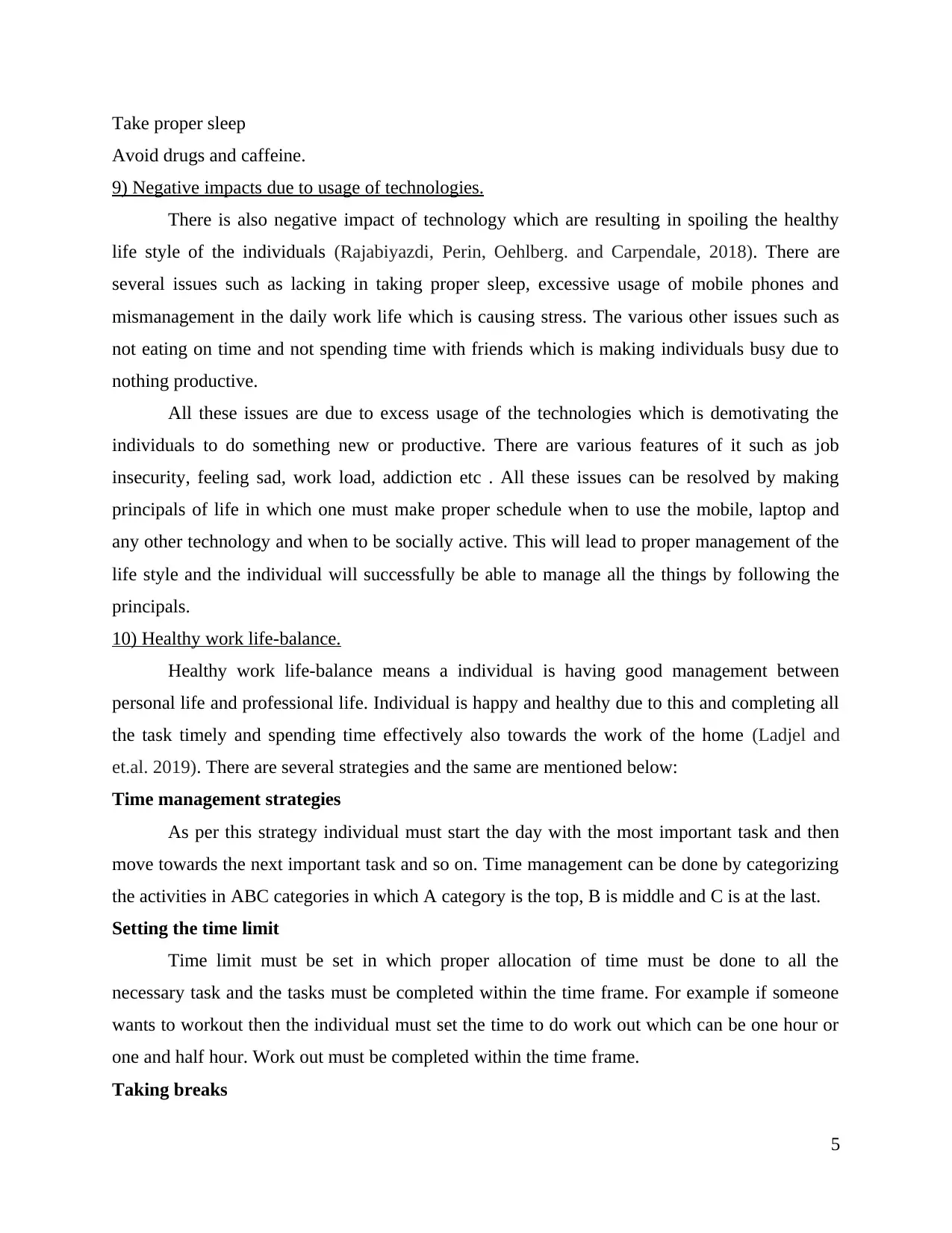
Take proper sleep
Avoid drugs and caffeine.
9) Negative impacts due to usage of technologies.
There is also negative impact of technology which are resulting in spoiling the healthy
life style of the individuals (Rajabiyazdi, Perin, Oehlberg. and Carpendale, 2018). There are
several issues such as lacking in taking proper sleep, excessive usage of mobile phones and
mismanagement in the daily work life which is causing stress. The various other issues such as
not eating on time and not spending time with friends which is making individuals busy due to
nothing productive.
All these issues are due to excess usage of the technologies which is demotivating the
individuals to do something new or productive. There are various features of it such as job
insecurity, feeling sad, work load, addiction etc . All these issues can be resolved by making
principals of life in which one must make proper schedule when to use the mobile, laptop and
any other technology and when to be socially active. This will lead to proper management of the
life style and the individual will successfully be able to manage all the things by following the
principals.
10) Healthy work life-balance.
Healthy work life-balance means a individual is having good management between
personal life and professional life. Individual is happy and healthy due to this and completing all
the task timely and spending time effectively also towards the work of the home (Ladjel and
et.al. 2019). There are several strategies and the same are mentioned below:
Time management strategies
As per this strategy individual must start the day with the most important task and then
move towards the next important task and so on. Time management can be done by categorizing
the activities in ABC categories in which A category is the top, B is middle and C is at the last.
Setting the time limit
Time limit must be set in which proper allocation of time must be done to all the
necessary task and the tasks must be completed within the time frame. For example if someone
wants to workout then the individual must set the time to do work out which can be one hour or
one and half hour. Work out must be completed within the time frame.
Taking breaks
5
Avoid drugs and caffeine.
9) Negative impacts due to usage of technologies.
There is also negative impact of technology which are resulting in spoiling the healthy
life style of the individuals (Rajabiyazdi, Perin, Oehlberg. and Carpendale, 2018). There are
several issues such as lacking in taking proper sleep, excessive usage of mobile phones and
mismanagement in the daily work life which is causing stress. The various other issues such as
not eating on time and not spending time with friends which is making individuals busy due to
nothing productive.
All these issues are due to excess usage of the technologies which is demotivating the
individuals to do something new or productive. There are various features of it such as job
insecurity, feeling sad, work load, addiction etc . All these issues can be resolved by making
principals of life in which one must make proper schedule when to use the mobile, laptop and
any other technology and when to be socially active. This will lead to proper management of the
life style and the individual will successfully be able to manage all the things by following the
principals.
10) Healthy work life-balance.
Healthy work life-balance means a individual is having good management between
personal life and professional life. Individual is happy and healthy due to this and completing all
the task timely and spending time effectively also towards the work of the home (Ladjel and
et.al. 2019). There are several strategies and the same are mentioned below:
Time management strategies
As per this strategy individual must start the day with the most important task and then
move towards the next important task and so on. Time management can be done by categorizing
the activities in ABC categories in which A category is the top, B is middle and C is at the last.
Setting the time limit
Time limit must be set in which proper allocation of time must be done to all the
necessary task and the tasks must be completed within the time frame. For example if someone
wants to workout then the individual must set the time to do work out which can be one hour or
one and half hour. Work out must be completed within the time frame.
Taking breaks
5
Paraphrase This Document
Need a fresh take? Get an instant paraphrase of this document with our AI Paraphraser
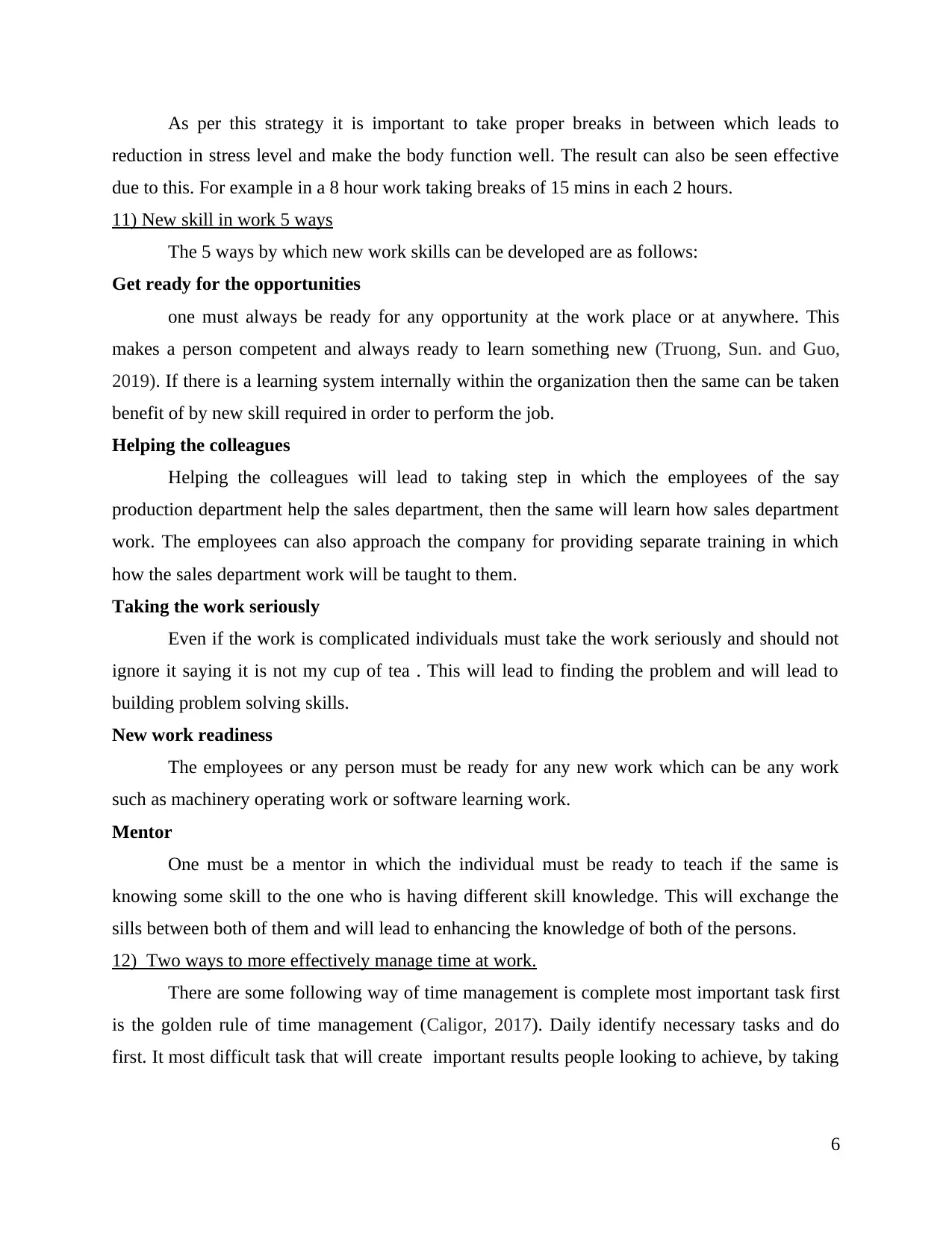
As per this strategy it is important to take proper breaks in between which leads to
reduction in stress level and make the body function well. The result can also be seen effective
due to this. For example in a 8 hour work taking breaks of 15 mins in each 2 hours.
11) New skill in work 5 ways
The 5 ways by which new work skills can be developed are as follows:
Get ready for the opportunities
one must always be ready for any opportunity at the work place or at anywhere. This
makes a person competent and always ready to learn something new (Truong, Sun. and Guo,
2019). If there is a learning system internally within the organization then the same can be taken
benefit of by new skill required in order to perform the job.
Helping the colleagues
Helping the colleagues will lead to taking step in which the employees of the say
production department help the sales department, then the same will learn how sales department
work. The employees can also approach the company for providing separate training in which
how the sales department work will be taught to them.
Taking the work seriously
Even if the work is complicated individuals must take the work seriously and should not
ignore it saying it is not my cup of tea . This will lead to finding the problem and will lead to
building problem solving skills.
New work readiness
The employees or any person must be ready for any new work which can be any work
such as machinery operating work or software learning work.
Mentor
One must be a mentor in which the individual must be ready to teach if the same is
knowing some skill to the one who is having different skill knowledge. This will exchange the
sills between both of them and will lead to enhancing the knowledge of both of the persons.
12) Two ways to more effectively manage time at work.
There are some following way of time management is complete most important task first
is the golden rule of time management (Caligor, 2017). Daily identify necessary tasks and do
first. It most difficult task that will create important results people looking to achieve, by taking
6
reduction in stress level and make the body function well. The result can also be seen effective
due to this. For example in a 8 hour work taking breaks of 15 mins in each 2 hours.
11) New skill in work 5 ways
The 5 ways by which new work skills can be developed are as follows:
Get ready for the opportunities
one must always be ready for any opportunity at the work place or at anywhere. This
makes a person competent and always ready to learn something new (Truong, Sun. and Guo,
2019). If there is a learning system internally within the organization then the same can be taken
benefit of by new skill required in order to perform the job.
Helping the colleagues
Helping the colleagues will lead to taking step in which the employees of the say
production department help the sales department, then the same will learn how sales department
work. The employees can also approach the company for providing separate training in which
how the sales department work will be taught to them.
Taking the work seriously
Even if the work is complicated individuals must take the work seriously and should not
ignore it saying it is not my cup of tea . This will lead to finding the problem and will lead to
building problem solving skills.
New work readiness
The employees or any person must be ready for any new work which can be any work
such as machinery operating work or software learning work.
Mentor
One must be a mentor in which the individual must be ready to teach if the same is
knowing some skill to the one who is having different skill knowledge. This will exchange the
sills between both of them and will lead to enhancing the knowledge of both of the persons.
12) Two ways to more effectively manage time at work.
There are some following way of time management is complete most important task first
is the golden rule of time management (Caligor, 2017). Daily identify necessary tasks and do
first. It most difficult task that will create important results people looking to achieve, by taking
6
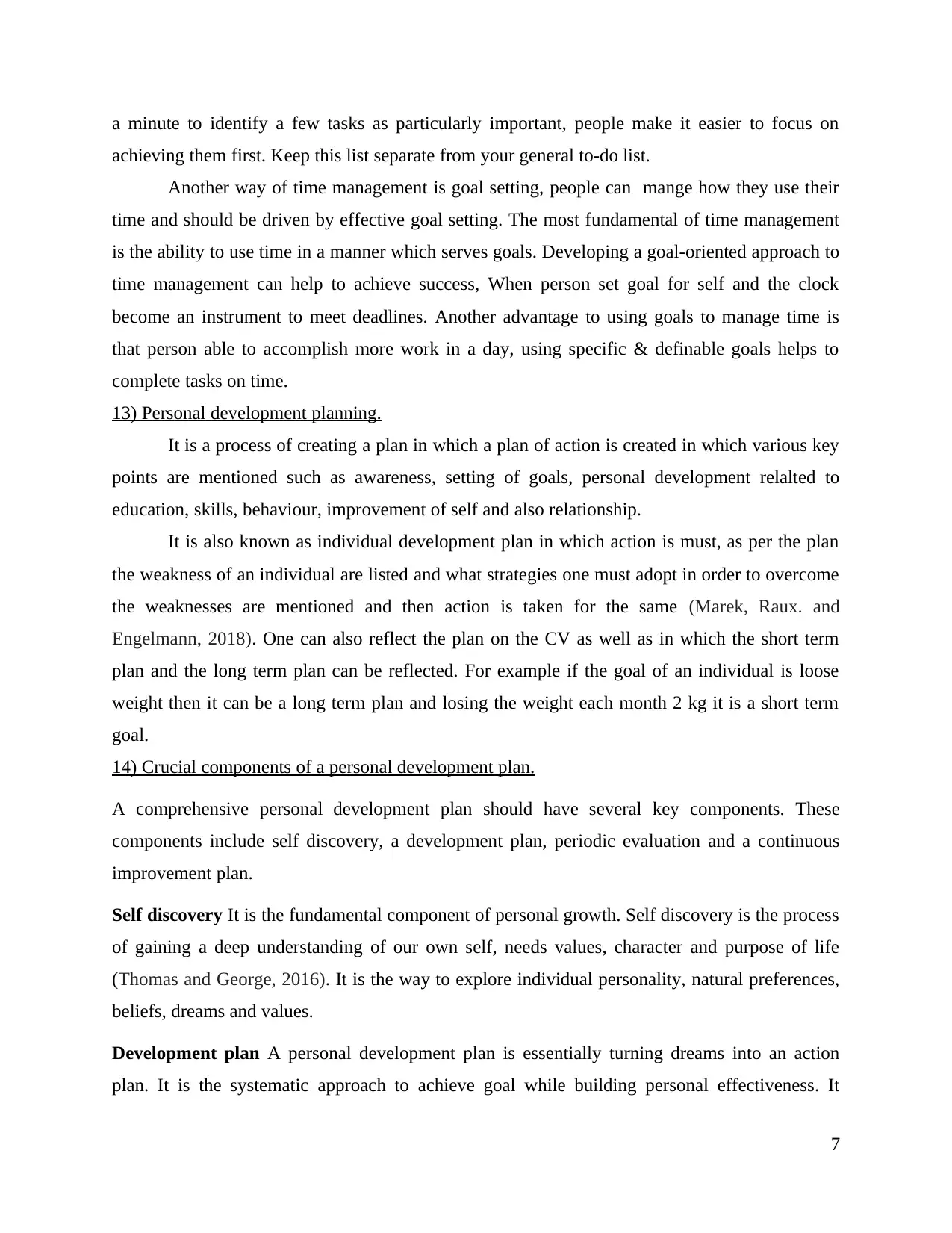
a minute to identify a few tasks as particularly important, people make it easier to focus on
achieving them first. Keep this list separate from your general to-do list.
Another way of time management is goal setting, people can mange how they use their
time and should be driven by effective goal setting. The most fundamental of time management
is the ability to use time in a manner which serves goals. Developing a goal-oriented approach to
time management can help to achieve success, When person set goal for self and the clock
become an instrument to meet deadlines. Another advantage to using goals to manage time is
that person able to accomplish more work in a day, using specific & definable goals helps to
complete tasks on time.
13) Personal development planning.
It is a process of creating a plan in which a plan of action is created in which various key
points are mentioned such as awareness, setting of goals, personal development relalted to
education, skills, behaviour, improvement of self and also relationship.
It is also known as individual development plan in which action is must, as per the plan
the weakness of an individual are listed and what strategies one must adopt in order to overcome
the weaknesses are mentioned and then action is taken for the same (Marek, Raux. and
Engelmann, 2018). One can also reflect the plan on the CV as well as in which the short term
plan and the long term plan can be reflected. For example if the goal of an individual is loose
weight then it can be a long term plan and losing the weight each month 2 kg it is a short term
goal.
14) Crucial components of a personal development plan.
A comprehensive personal development plan should have several key components. These
components include self discovery, a development plan, periodic evaluation and a continuous
improvement plan.
Self discovery It is the fundamental component of personal growth. Self discovery is the process
of gaining a deep understanding of our own self, needs values, character and purpose of life
(Thomas and George, 2016). It is the way to explore individual personality, natural preferences,
beliefs, dreams and values.
Development plan A personal development plan is essentially turning dreams into an action
plan. It is the systematic approach to achieve goal while building personal effectiveness. It
7
achieving them first. Keep this list separate from your general to-do list.
Another way of time management is goal setting, people can mange how they use their
time and should be driven by effective goal setting. The most fundamental of time management
is the ability to use time in a manner which serves goals. Developing a goal-oriented approach to
time management can help to achieve success, When person set goal for self and the clock
become an instrument to meet deadlines. Another advantage to using goals to manage time is
that person able to accomplish more work in a day, using specific & definable goals helps to
complete tasks on time.
13) Personal development planning.
It is a process of creating a plan in which a plan of action is created in which various key
points are mentioned such as awareness, setting of goals, personal development relalted to
education, skills, behaviour, improvement of self and also relationship.
It is also known as individual development plan in which action is must, as per the plan
the weakness of an individual are listed and what strategies one must adopt in order to overcome
the weaknesses are mentioned and then action is taken for the same (Marek, Raux. and
Engelmann, 2018). One can also reflect the plan on the CV as well as in which the short term
plan and the long term plan can be reflected. For example if the goal of an individual is loose
weight then it can be a long term plan and losing the weight each month 2 kg it is a short term
goal.
14) Crucial components of a personal development plan.
A comprehensive personal development plan should have several key components. These
components include self discovery, a development plan, periodic evaluation and a continuous
improvement plan.
Self discovery It is the fundamental component of personal growth. Self discovery is the process
of gaining a deep understanding of our own self, needs values, character and purpose of life
(Thomas and George, 2016). It is the way to explore individual personality, natural preferences,
beliefs, dreams and values.
Development plan A personal development plan is essentially turning dreams into an action
plan. It is the systematic approach to achieve goal while building personal effectiveness. It
7
⊘ This is a preview!⊘
Do you want full access?
Subscribe today to unlock all pages.

Trusted by 1+ million students worldwide
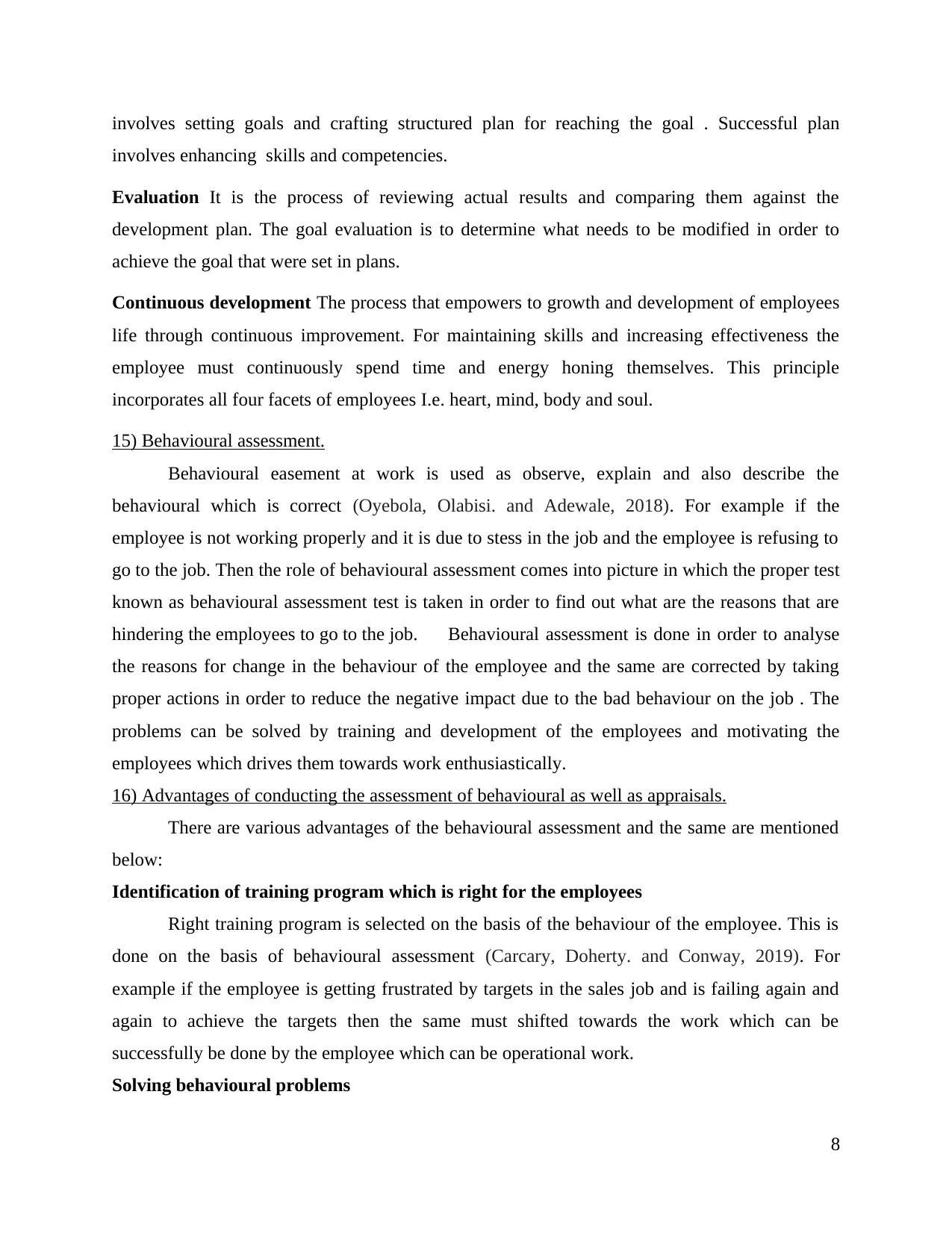
involves setting goals and crafting structured plan for reaching the goal . Successful plan
involves enhancing skills and competencies.
Evaluation It is the process of reviewing actual results and comparing them against the
development plan. The goal evaluation is to determine what needs to be modified in order to
achieve the goal that were set in plans.
Continuous development The process that empowers to growth and development of employees
life through continuous improvement. For maintaining skills and increasing effectiveness the
employee must continuously spend time and energy honing themselves. This principle
incorporates all four facets of employees I.e. heart, mind, body and soul.
15) Behavioural assessment.
Behavioural easement at work is used as observe, explain and also describe the
behavioural which is correct (Oyebola, Olabisi. and Adewale, 2018). For example if the
employee is not working properly and it is due to stess in the job and the employee is refusing to
go to the job. Then the role of behavioural assessment comes into picture in which the proper test
known as behavioural assessment test is taken in order to find out what are the reasons that are
hindering the employees to go to the job. Behavioural assessment is done in order to analyse
the reasons for change in the behaviour of the employee and the same are corrected by taking
proper actions in order to reduce the negative impact due to the bad behaviour on the job . The
problems can be solved by training and development of the employees and motivating the
employees which drives them towards work enthusiastically.
16) Advantages of conducting the assessment of behavioural as well as appraisals.
There are various advantages of the behavioural assessment and the same are mentioned
below:
Identification of training program which is right for the employees
Right training program is selected on the basis of the behaviour of the employee. This is
done on the basis of behavioural assessment (Carcary, Doherty. and Conway, 2019). For
example if the employee is getting frustrated by targets in the sales job and is failing again and
again to achieve the targets then the same must shifted towards the work which can be
successfully be done by the employee which can be operational work.
Solving behavioural problems
8
involves enhancing skills and competencies.
Evaluation It is the process of reviewing actual results and comparing them against the
development plan. The goal evaluation is to determine what needs to be modified in order to
achieve the goal that were set in plans.
Continuous development The process that empowers to growth and development of employees
life through continuous improvement. For maintaining skills and increasing effectiveness the
employee must continuously spend time and energy honing themselves. This principle
incorporates all four facets of employees I.e. heart, mind, body and soul.
15) Behavioural assessment.
Behavioural easement at work is used as observe, explain and also describe the
behavioural which is correct (Oyebola, Olabisi. and Adewale, 2018). For example if the
employee is not working properly and it is due to stess in the job and the employee is refusing to
go to the job. Then the role of behavioural assessment comes into picture in which the proper test
known as behavioural assessment test is taken in order to find out what are the reasons that are
hindering the employees to go to the job. Behavioural assessment is done in order to analyse
the reasons for change in the behaviour of the employee and the same are corrected by taking
proper actions in order to reduce the negative impact due to the bad behaviour on the job . The
problems can be solved by training and development of the employees and motivating the
employees which drives them towards work enthusiastically.
16) Advantages of conducting the assessment of behavioural as well as appraisals.
There are various advantages of the behavioural assessment and the same are mentioned
below:
Identification of training program which is right for the employees
Right training program is selected on the basis of the behaviour of the employee. This is
done on the basis of behavioural assessment (Carcary, Doherty. and Conway, 2019). For
example if the employee is getting frustrated by targets in the sales job and is failing again and
again to achieve the targets then the same must shifted towards the work which can be
successfully be done by the employee which can be operational work.
Solving behavioural problems
8
Paraphrase This Document
Need a fresh take? Get an instant paraphrase of this document with our AI Paraphraser
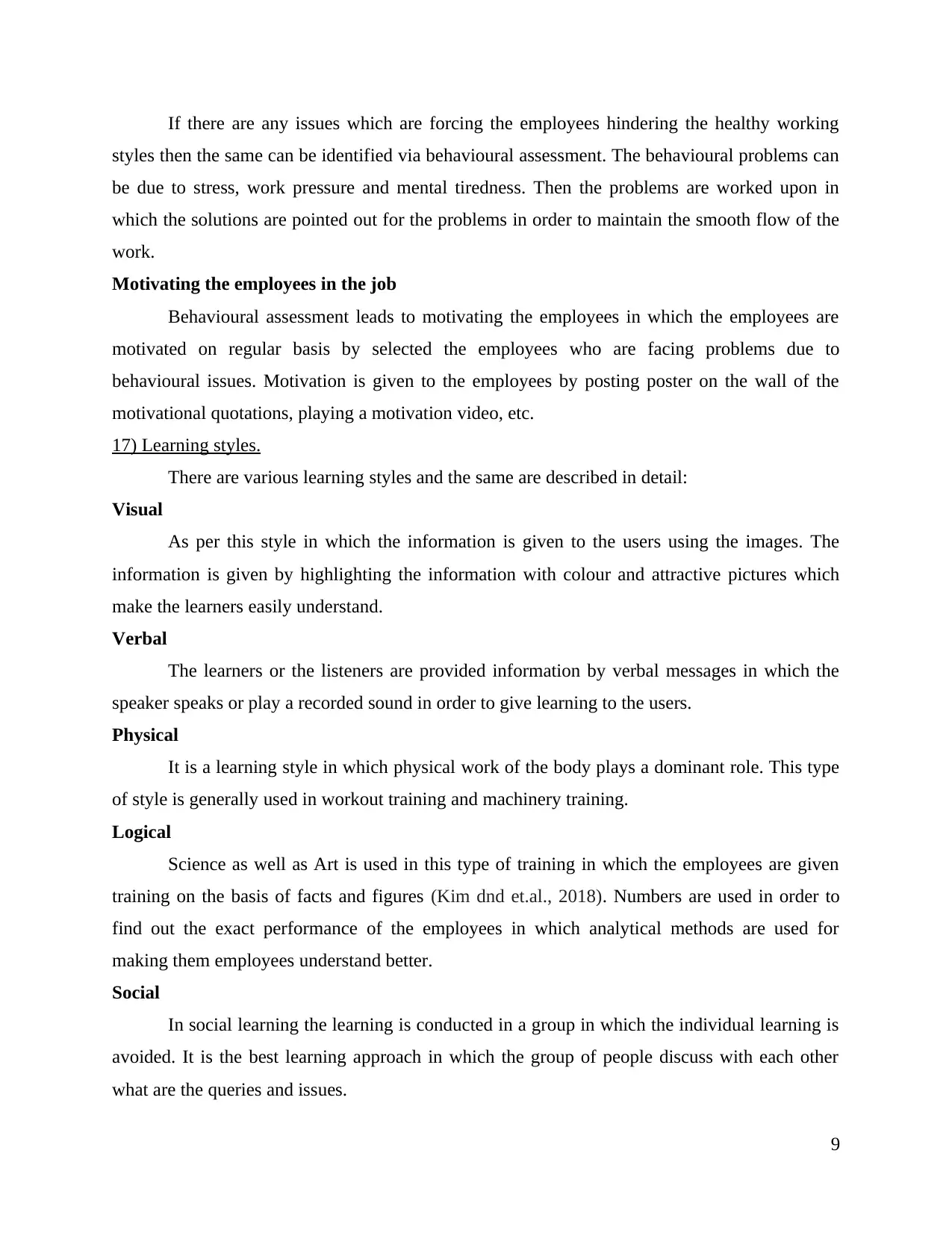
If there are any issues which are forcing the employees hindering the healthy working
styles then the same can be identified via behavioural assessment. The behavioural problems can
be due to stress, work pressure and mental tiredness. Then the problems are worked upon in
which the solutions are pointed out for the problems in order to maintain the smooth flow of the
work.
Motivating the employees in the job
Behavioural assessment leads to motivating the employees in which the employees are
motivated on regular basis by selected the employees who are facing problems due to
behavioural issues. Motivation is given to the employees by posting poster on the wall of the
motivational quotations, playing a motivation video, etc.
17) Learning styles.
There are various learning styles and the same are described in detail:
Visual
As per this style in which the information is given to the users using the images. The
information is given by highlighting the information with colour and attractive pictures which
make the learners easily understand.
Verbal
The learners or the listeners are provided information by verbal messages in which the
speaker speaks or play a recorded sound in order to give learning to the users.
Physical
It is a learning style in which physical work of the body plays a dominant role. This type
of style is generally used in workout training and machinery training.
Logical
Science as well as Art is used in this type of training in which the employees are given
training on the basis of facts and figures (Kim dnd et.al., 2018). Numbers are used in order to
find out the exact performance of the employees in which analytical methods are used for
making them employees understand better.
Social
In social learning the learning is conducted in a group in which the individual learning is
avoided. It is the best learning approach in which the group of people discuss with each other
what are the queries and issues.
9
styles then the same can be identified via behavioural assessment. The behavioural problems can
be due to stress, work pressure and mental tiredness. Then the problems are worked upon in
which the solutions are pointed out for the problems in order to maintain the smooth flow of the
work.
Motivating the employees in the job
Behavioural assessment leads to motivating the employees in which the employees are
motivated on regular basis by selected the employees who are facing problems due to
behavioural issues. Motivation is given to the employees by posting poster on the wall of the
motivational quotations, playing a motivation video, etc.
17) Learning styles.
There are various learning styles and the same are described in detail:
Visual
As per this style in which the information is given to the users using the images. The
information is given by highlighting the information with colour and attractive pictures which
make the learners easily understand.
Verbal
The learners or the listeners are provided information by verbal messages in which the
speaker speaks or play a recorded sound in order to give learning to the users.
Physical
It is a learning style in which physical work of the body plays a dominant role. This type
of style is generally used in workout training and machinery training.
Logical
Science as well as Art is used in this type of training in which the employees are given
training on the basis of facts and figures (Kim dnd et.al., 2018). Numbers are used in order to
find out the exact performance of the employees in which analytical methods are used for
making them employees understand better.
Social
In social learning the learning is conducted in a group in which the individual learning is
avoided. It is the best learning approach in which the group of people discuss with each other
what are the queries and issues.
9
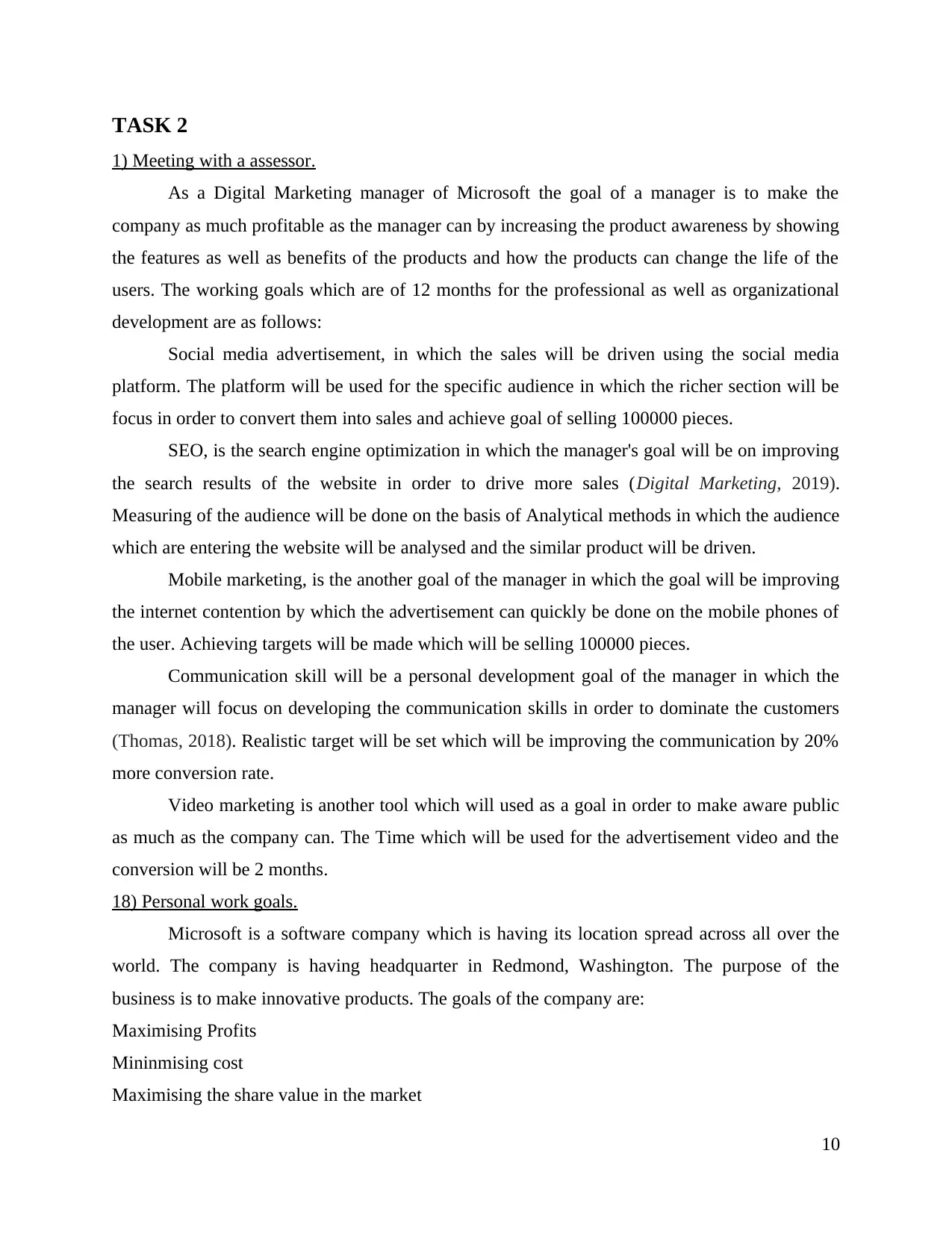
TASK 2
1) Meeting with a assessor.
As a Digital Marketing manager of Microsoft the goal of a manager is to make the
company as much profitable as the manager can by increasing the product awareness by showing
the features as well as benefits of the products and how the products can change the life of the
users. The working goals which are of 12 months for the professional as well as organizational
development are as follows:
Social media advertisement, in which the sales will be driven using the social media
platform. The platform will be used for the specific audience in which the richer section will be
focus in order to convert them into sales and achieve goal of selling 100000 pieces.
SEO, is the search engine optimization in which the manager's goal will be on improving
the search results of the website in order to drive more sales (Digital Marketing, 2019).
Measuring of the audience will be done on the basis of Analytical methods in which the audience
which are entering the website will be analysed and the similar product will be driven.
Mobile marketing, is the another goal of the manager in which the goal will be improving
the internet contention by which the advertisement can quickly be done on the mobile phones of
the user. Achieving targets will be made which will be selling 100000 pieces.
Communication skill will be a personal development goal of the manager in which the
manager will focus on developing the communication skills in order to dominate the customers
(Thomas, 2018). Realistic target will be set which will be improving the communication by 20%
more conversion rate.
Video marketing is another tool which will used as a goal in order to make aware public
as much as the company can. The Time which will be used for the advertisement video and the
conversion will be 2 months.
18) Personal work goals.
Microsoft is a software company which is having its location spread across all over the
world. The company is having headquarter in Redmond, Washington. The purpose of the
business is to make innovative products. The goals of the company are:
Maximising Profits
Mininmising cost
Maximising the share value in the market
10
1) Meeting with a assessor.
As a Digital Marketing manager of Microsoft the goal of a manager is to make the
company as much profitable as the manager can by increasing the product awareness by showing
the features as well as benefits of the products and how the products can change the life of the
users. The working goals which are of 12 months for the professional as well as organizational
development are as follows:
Social media advertisement, in which the sales will be driven using the social media
platform. The platform will be used for the specific audience in which the richer section will be
focus in order to convert them into sales and achieve goal of selling 100000 pieces.
SEO, is the search engine optimization in which the manager's goal will be on improving
the search results of the website in order to drive more sales (Digital Marketing, 2019).
Measuring of the audience will be done on the basis of Analytical methods in which the audience
which are entering the website will be analysed and the similar product will be driven.
Mobile marketing, is the another goal of the manager in which the goal will be improving
the internet contention by which the advertisement can quickly be done on the mobile phones of
the user. Achieving targets will be made which will be selling 100000 pieces.
Communication skill will be a personal development goal of the manager in which the
manager will focus on developing the communication skills in order to dominate the customers
(Thomas, 2018). Realistic target will be set which will be improving the communication by 20%
more conversion rate.
Video marketing is another tool which will used as a goal in order to make aware public
as much as the company can. The Time which will be used for the advertisement video and the
conversion will be 2 months.
18) Personal work goals.
Microsoft is a software company which is having its location spread across all over the
world. The company is having headquarter in Redmond, Washington. The purpose of the
business is to make innovative products. The goals of the company are:
Maximising Profits
Mininmising cost
Maximising the share value in the market
10
⊘ This is a preview!⊘
Do you want full access?
Subscribe today to unlock all pages.

Trusted by 1+ million students worldwide
1 out of 16
Related Documents
Your All-in-One AI-Powered Toolkit for Academic Success.
+13062052269
info@desklib.com
Available 24*7 on WhatsApp / Email
![[object Object]](/_next/static/media/star-bottom.7253800d.svg)
Unlock your academic potential
Copyright © 2020–2025 A2Z Services. All Rights Reserved. Developed and managed by ZUCOL.





